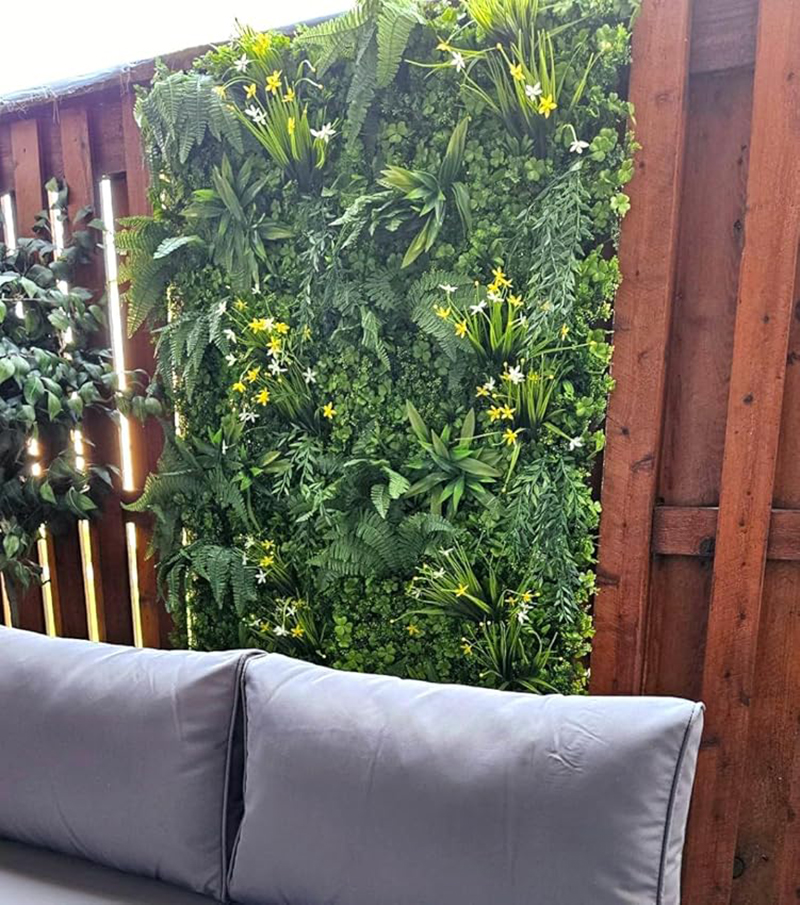Selecting Planting Containers for 3D Artificial Vertical Gardens: Enhancing Durability, Aesthetics, and Functional Integration
The success of a 3D artificial vertical garden depends not only on plant selection but also on the choice of planting containers. These containers must balance structural integrity, moisture resistance, and visual harmony with the surrounding design. Unlike traditional planters, containers for vertical gardens require lightweight materials, secure attachment methods, and the ability to accommodate irregular shapes or multi-tiered arrangements. Below are key considerations for choosing containers that support both the practical and aesthetic needs of artificial vertical gardens.

Artificial vertical gardens are often exposed to varying environmental conditions, from indoor humidity to outdoor sunlight and temperature fluctuations. Selecting containers made from durable, weather-resistant materials ensures the garden remains intact and visually appealing over time.
Recycled Plastic Containers for Lightweight Flexibility: Containers crafted from recycled plastics offer a balance of strength and lightweight design, making them easy to install and reposition. These materials resist cracking, fading, and warping, even when exposed to UV rays or moisture, ensuring longevity in both indoor and outdoor settings.
Fiberglass Containers for Molding Complex Shapes: Fiberglass is ideal for creating containers with organic curves or irregular forms, such as those mimicking natural rock formations or flowing waves. Its non-corrosive nature and ability to withstand extreme temperatures make it suitable for outdoor installations, while its smooth finish allows for custom painting or texturing.
Metal-Reinforced Composite Containers for Added Stability: Combining metal frames with composite materials, such as resin or recycled wood fibers, creates containers that are both sturdy and resistant to deformation. These designs work well for supporting heavier artificial plants or for gardens installed in high-wind areas, where additional structural support is necessary.
While artificial plants do not require soil or water, their containers must still accommodate the base or "root" structure securely. The size and depth of the container influence the stability of the plants and the overall visual balance of the garden.
Shallow Containers for Lightweight Artificial Plants: For smaller artificial plants or those with minimal base structures, shallow containers reduce weight and prevent the garden from feeling top-heavy. These designs are particularly useful for wall-mounted installations or when creating a cascading effect with trailing plants.
Deep Containers for Stability in Multi-Tiered Gardens: When arranging artificial plants in tiers or clusters, deeper containers provide a stable foundation, especially for taller or heavier designs. These containers also allow for hidden anchoring mechanisms, such as weights or brackets, to ensure the garden remains securely attached to the wall.
Modular Containers for Scalable Designs: Using interlocking or stackable containers enables the creation of larger, more complex gardens without the need for custom fabrication. These modular systems allow for easy expansion or reconfiguration, making them ideal for commercial spaces or dynamic installations where the design may evolve over time.
Although artificial plants do not require watering, containers may still accumulate condensation or moisture from humid environments. Proper drainage and ventilation prevent water buildup, which can lead to mold, mildew, or damage to the container material over time.
Perforated Containers for Air Circulation: Containers with small holes or slits along the sides or bottom promote airflow, reducing humidity and preventing stagnant moisture. These designs are particularly important for indoor gardens or in climates with high humidity levels.
Elevated Base Designs for Water Runoff: Containers with raised bases or feet allow excess water to drain away from the container, protecting both the artificial plants and the wall surface from water damage. These designs are useful for outdoor gardens exposed to rain or for indoor spaces where occasional spills may occur.
Removable Drainage Plugs for Customizable Control: Some containers feature removable plugs or caps that allow users to adjust drainage based on environmental conditions. This flexibility ensures the garden remains dry in humid settings while preventing water loss in drier climates, though it is more relevant for hybrid gardens that may include real plants.
The appearance of the containers should complement the artificial plants and the surrounding space, whether the garden is installed indoors or outdoors. Choosing containers that blend seamlessly with the design enhances the overall visual impact and creates a cohesive look.
Neutral-Colored Containers for Versatile Styling: Containers in shades of gray, black, or earth tones provide a subtle backdrop that allows the artificial plants to take center stage. These neutral colors work well in any setting, from modern offices to traditional homes, and can be easily painted or covered if a different look is desired.
Textured Containers for Natural Appeal: Containers with rough finishes, such as those mimicking stone, concrete, or weathered wood, add a tactile element that enhances the garden’s organic feel. These designs work particularly well in outdoor settings or when creating a rustic or earthy aesthetic.
Customizable Containers for Branding or Thematic Consistency: For commercial spaces or themed installations, containers can be customized with logos, patterns, or colors that align with the brand or design concept. This level of personalization ensures the garden not only functions as a decorative element but also reinforces the identity of the space.
By prioritizing material durability, appropriate sizing, moisture management, and aesthetic harmony, the right containers can elevate a 3D artificial vertical garden from a simple wall decoration to a striking, long-lasting installation. These considerations ensure the garden remains secure, visually appealing, and adaptable to any environment.
Contact: Amy
Phone: 86-15311787313
E-mail: info@foszmac.com
Whatsapp:86-15311787313
Add: Fengtai District, Dacheng Road, No.24 Building, Room 203, Beijing, China